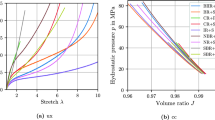Abstract
In the paper, we analyze problems of elasticity tensor identification for an elastic body with incorporated thin elastic and rigid inclusions in a non-coercive case. The inclusions are assumed to be delaminated from the surrounding elastic body, thus forming interfacial cracks. We consider inequality-type boundary conditions at the crack faces with unknown set of a contact to provide a mutual non-penetration between the crack faces. The considered problems are characterized by unknown displacement field and elasticity tensor. A formulation of identification problems includes an additional information, which can be found from a measurement. A solution existence of these problems is proved.

Similar content being viewed by others
Data availability
Data sharing is not applicable to this article as no datasets were generated or analyzed during the current study.
References
Alessandrini, G., Di Cristo, M., Morassi, A., Rosset, E.: Stable determination of an inclusion in an elastic body by boundary measurements. SIAM J. Math. Anal. 46, 2692–2729 (2014)
Bonnet, M., Constantinescu, A.: Inverse problems in elasticity. Inverse Prob. 21, R1–R50 (2005)
Chambolle, A., Frankfort, G.A., Margo, J.-J.: When and how do cracks propagate? J. Mech. Phys. Solids 57, 1614–1622 (2009)
Durante, T., Mel’nyk, T.A.: Asymptotic analysis of an optimal control problem involving a thick two-level junction with alternate type of controls. J. Opt. Theory Appl. 144, 205–225 (2010)
Eskin, G., Ralston, J.: On the inverse boundary value problem for linear isotropic elasticity. Inverse Prob. 18, 907–921 (2002)
Frankfort, G.A., Margo, J.-J.: Revisiting brittle fracture as an energy minimization problem. J. Mech. Phys. Solids 46, 1319–1342 (1998)
Hintermueller, M., Kovtunenko, V.A., Kunisch, K.: Obstacle problems with cohesion: a hemi-variational inequality approach and its efficient numerical solution. SIAM J. Optim. 21, 491–516 (2011)
Hintermuller, M.: Inverse coefficient problems for variational inequalities: optimality conditions and numerical realization. ESAIM M2AN 35, 129–152 (2001)
Ikehata, M.: Reconstruction of inclusion from boundary measurements. J. Inverse Ill Posed Probl. 10, 37–65 (2002)
Jadamba, B., Khan, A.A., Sama, M.: Inverse problems of parameter identification in partial differential equations. Math. Sci. Tech. (2011). https://doi.org/10.1142/9789814338820_0009
Jadamba, B., Khan, A.A., Racitic, F.: On the inverse problem of identifying Lamé coeffcients in linear elasticity. Comput. Math. Appl. 56, 431–443 (2008)
Khludnev, A.M.: Elasticity Problems in Non-smooth Domains. Fizmatlit, Moscow (2010)
Khludnev, A.M.: Inverse problems for elastic body with closely located thin inclusions. Z. Angew. Math. Phys. 70, 134 (2019)
Khludnev, A.M.: Inverse problem for elastic body with thin elastic inclusion. J. Inverse Ill Posed Probl. 2, 195–209 (2020)
Khludnev, A.M., Fankina, I.V.: Equilibrium problem for elastic plate with thin rigid inclusion crossing an external boundary. Z. Angew. Math. Phys. 72, 121 (2021)
Khludnev, A.M.: Rigidity parameter identification for thin inclusions located inside elastic bodies. J. Opt. Theory Appl. 172, 281–297 (2017)
Khludnev, A.M., Corbo Esposito, A., Faella, L.: Optimal control of parameters for elastic body with thin inclusions. J. Opt. Theory Appl. 184, 293–314 (2020)
Khludnev, A.M., Faella, L., Perugia, C.: Optimal control of rigidity parameters of thin inclusions in composite materials. Z. Angew. Math. Phys. 68, 47 (2017)
Khludnev, A.M., Popova, T.S.: Equilibrium problem for elastic body with delaminated T-shape inclusion. J. Comput. Appl. Math. 376, 112870 (2020)
Knowles, I.: Parameter identification for elliptic problems. J. Comput. Appl. Math. 131, 175–194 (2001)
Kovtunenko, V.A., Leugering, G.: A shape-topological control problem for nonlinear crack-defect interaction: the anti-plane variational model. SIAM J. Control. Optim. 54, 1329–1351 (2016)
Kozlov, V.A., Mazya, V.G., Movchan, A.V.: Asymptotic analysis of fields in a multi-structure. Oxford University Press, New York (1999)
Lazarev, N.P., Rudoy, E.M.: Shape sensitivity analysis of Timoshenko plate with a crack under the nonpenetration condition. Z. Angew. Math. Mech. 94, 730–739 (2014)
Lazarev, N.P.: Shape sensitivity analysis of the energy integrals for the Timoshenko-type plate containing a crack on the boundary of a rigid inclusion. Z. Angew. Math. Phys. 66, 2025–2040 (2015)
Lazarev, N.P., Semenova, G.: An optimal size of a rigid thin stiffener reinforcing an elastic two-dimensional body on the outer edge. J. Opt. Theory Appl. 178, 614–626 (2018)
Mallick, P.K.: Fiber-Reinforced Composites Materials, Manufacturing, and Design. Marcel Dekker, Inc., New York (1993)
Nakamura, G., Uhlmann, G.: Identification of Lame parameters by boundary measurements. Am. J. Math. 115, 1161–1187 (1993)
Nakamura, G., Uhlmann, G.: Global uniqueness for an inverse boundary value problem arising in elasticity. Invent. Math. 118, 457–474 (1994)
Panasenko, G.: Multi-scale Modelling for Structures and Composites. Springer, New York (2005)
Pasternak, I.M.: Plane problem of elasticity theory for anisotropic bodies with thin elastic inclusions. J. Mathem. Sci. 186, 31–47 (2012)
Rudoy, E.M.: Shape derivative of the energy functional in a problem for a thin rigid inclusion in an elastic body. Z. Angew. Math. Phys. 66, 1923–1937 (2015)
Saccomandi, G., Beatty, M.F.: Universal relations for fiber-reinforced elastic materials. Math. Mech. Solids 7, 99–110 (2002)
Shcherbakov, V.V.: Shape optimization of rigid inclusions in elastic plates with cracks. Z. Angew. Math. Phys. 67, 71 (2016)
Vatulyan, A.O.: Inverse Problems in Solid Mechanics. Fizmatlit, Moscow (2007)
Acknowledgements
The research is partially funded by the Ministry of Science and Higher Education of the Russian Federation as part of World-class Research Center program: Advanced Digital Technologies (contract No. 075-15-2020-903 dated 16 November 2020).
Author information
Authors and Affiliations
Corresponding author
Additional information
Communicated by Christiane Tammer.
Publisher's Note
Springer Nature remains neutral with regard to jurisdictional claims in published maps and institutional affiliations.
Rights and permissions
Springer Nature or its licensor (e.g. a society or other partner) holds exclusive rights to this article under a publishing agreement with the author(s) or other rightsholder(s); author self-archiving of the accepted manuscript version of this article is solely governed by the terms of such publishing agreement and applicable law.
About this article
Cite this article
Khludnev, A., Rodionov, A. Elasticity Tensor Identification in Elastic Body with Thin Inclusions: Non-coercive Case. J Optim Theory Appl 197, 993–1010 (2023). https://doi.org/10.1007/s10957-023-02216-1
Received:
Accepted:
Published:
Issue Date:
DOI: https://doi.org/10.1007/s10957-023-02216-1
Keywords
- Elastic body
- Thin inclusion
- Crack
- Variational inequality
- Non-coercive boundary value problem
- Inverse problem




